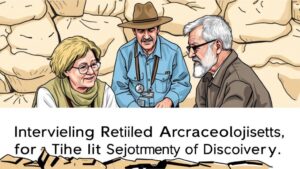Surveying Riverbeds After Floods to Discover Newly Exposed Artifacts
Introduction
Flood events have long been catalysts for the exposure of archaeological artifacts, making the study of riverbeds post-flood crucial for historians and archaeologists alike. This article examines the methodologies, implications, and significance of surveying riverbeds after floods, illustrated through recent case studies and evidence. By systematically investigating these newly exposed areas, researchers can uncover artifacts that reveal insights into past civilizations.
Methodologies in Riverbed Surveying
Various methodologies are employed to effectively survey riverbeds after flooding. e methodologies generally fall into two categories: direct observation and technological aids.
Direct Observation Techniques
Direct observation involves field surveys where archaeologists physically inspect the riverbed for exposed artifacts. This hands-on approach necessitates experienced personnel who can identify both historical artifacts and natural materials.
- Experienced archaeologists are tasked with visually identifying artifacts.
- Documentation is meticulously carried out to record artifacts locations and conditions.
Technological Methods
Innovative technologies, such as remote sensing and Geographic Information Systems (GIS), have revolutionized riverbed surveying.
- Remote Sensing: Techniques like LiDAR (Light Detection and Ranging) can penetrate through vegetation, allowing for a layer of analysis that maps ground structure before and after floods.
- GIS: GIS enables researchers to overlay historical data with current findings, creating a comparative framework of artifact locations against previously cataloged sites.
Case Studies
Several noteworthy case studies underscore the effectiveness of surveying riverbeds after flooding.
The 2016 Floods in Louisiana, USA
In 2016, heavy rains in Louisiana led to severe flooding, exposing numerous artifacts along the Amite River. Archaeologists identified Native American pottery shards and tools dated to circa 800 B.C. findings were documented in the Louisiana Archaeological Society Bulletin, showing the importance of rapid response in archaeological recovery efforts.
The Thames River Project, United Kingdom
Following significant flooding of the Thames in 2018, subsequent riverbed surveys revealed artifacts from the Roman occupation of Britain. This discovery not only provided physical evidence of past settlements but also prompted a reevaluation of the river’s historical significance. As noted by Professor Richard Hodges in the Journal of Historical Geography, such recoveries can shift historical narratives.
Significance of Artifact Recovery
The uncovering of artifacts through post-flood riverbed surveying has several implications:
- Cultural Heritage Preservation: Artifacts represent tangible links to cultural heritage, and their recovery can significantly impact local communities and historians alike.
- Historical Understanding: Artifacts provide essential data for understanding societal structures, trade routes, and daily life in ancient cultures.
Challenges and Considerations
Despite the advantages of riverbed surveying, several challenges persist. Environmental conditions often hinder access and recovery of artifacts. Also, there is an ongoing debate about the ethical implications of excavating artifacts, particularly in culturally sensitive areas.
Environmental Factors
Weather conditions and river flow can complicate or even prevent surveying efforts. For example, persistent flooding can further bury artifacts or wash them away entirely. Planners must take these variables into account to optimize recovery operations.
Ethical Considerations
Ethical considerations revolve around the legality and cultural implications of artifact recovery. Archaeologists must navigate local laws governing excavation rights and respect indigenous communities associated with the artifacts. The Society for American Archaeology emphasizes the importance of consultation and collaboration with local groups to ensure respectful practices.
Conclusion
Surveying riverbeds after floods presents significant opportunities for the discovery of newly exposed artifacts, enhancing historical knowledge and aiding in cultural preservation. Through a combination of direct observation and advanced technologies, archaeologists can effectively document these findings. Continued dialogue regarding the ethical ramifications of such excavations will ensure that these valuable resources are preserved and respected for future generations.
Actionable Takeaways
- Engage with local communities and historians to strengthen recovery efforts.
- Use cutting-edge technology to enhance surveying techniques.
- Use rapid response teams to capitalize on post-flood opportunities for artifact recovery.


